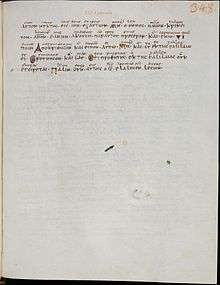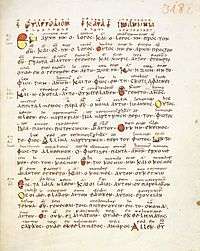Codex Sangallensis 48
|
The beginning of John | |
| Name | Sangallensis |
|---|---|
| Sign | Δ |
| Text | Gospels |
| Date | 9th century |
| Script | Greek-Latin |
| Now at | Abbey library of Saint Gall |
| Size | 23 cm by 18.5 cm |
| Type | Alexandrian / Byzantine |
| Category | III |
Codex Sangallensis, designated by Δ or 037 (in the Gregory-Aland numbering), ε 76 (von Soden), is a diglot Greek-Latin uncial manuscript of the four Gospels. Usually it is dated palaeographically to the 9th, only according to the opinions of few palaeographers to the 10th century.[1] It was named by Scholz in 1830.[2]
Description
The codex contains 198 parchment leaves (actual size 23 cm by 18.5 cm). The text is written in one column per page, and 17-28 lines per page,[1] in large semi-uncial letters.[3]
The codex contains almost the complete text of the four Gospels with only one lacuna in John 19:17-35. The Latin text is written above the Greek (as Codex Boernerianus) and in the minuscule letters. It is decorated, but decorations were made by inartistic hand.[4] The manuscript from which Sangallensis was copied was written stichometrically.
The text is divided according to Ammonian Sections, whose numbers are given at the margin, with references to the Eusebian Canons in Roman letters (written below Ammonian Section numbers). There are also τιτλοι (titles of chapters), given at the top of the pages.[3]
It contains prolegomena, the Epistle of Jerome to Pope Damasus I, the Eusebian Canon Tables, tables of the κεφαλαια (tables of contents) both in Greek and Latin.[3][5]
The texts of Mark 7:16 and 11:26 are omitted. The Pericope Adulterae (John 7:53-8:11) is omitted, but a blank space was left.
Text
The Greek text of the Gospel of Mark is a representative of the late Alexandrian text-type (similar to Codex L),[4] and in rest of the gospels the Byzantine text-type (as in Codex Athous Lavrensis). Aland placed it in Category III.[1]
- Textual variants
- In Matthew 27:35 it has additional phrase τα ιματια μου εαυτοις, και επι τον ιματισμον μου εβαλον κληρον together with codices: Θ, 0250, f1, f13, 537, 1424.
- In Matthew 1:12 it reads Ζορομβαβαβελ for Ζοροβαβελ.[6]
- In Mark 4:19 it has unique variant η αγαπη του πλουτου (the love of wealth), other manuscripts have η απατη του πλουτου, απαται του πλουτου or απαται του κοσμου.[7]
- In Mark 9:49 it reads πας γαρ πυρι αλισθησεται – as manuscripts (א εν πυρι) B L W f1 f13 28 565 700 ℓ 260 syrs copsa.
Latin text
The Latin version seems a mixture of the Vulgate with Old Latin Itala, and altered and accommodated to the Greek as to be of little critical value.
The interlinear Latin text of the codex is remarkable for its alternative readings in almost every verse, e.g. uxorem vel coniugem for την γυναικα in Matthew 1:20.[9]
History
The codex was written in the West, possibly in the St. Gallen monastery, by an Irish monk in the 9th century.[10] It can not be dated earlier, because it has a reference to the (heretical) opinions of Gottschalk at Luke 13:24, John 12:40.
Siglum Δ was given by Scholz.[11]
It was examined by Martin Gerbert (1773), Scholz, Rettig, J. Rendel Harris, Oscar von Gebhardt. Rettig thought that Codex Sangallensis is a part of the same manuscript as the Codex Boernerianus.[10]
The text of the codex was edited by H. C. M. Rettig in 1836, but with some mistakes (e.g. in Luke 21:32 οφθαλμους instead of αδελφους).[4] There are references made to the opinions of Gottschalk († 866) in Luke 13:24; John 12:40 and to Hand Aragon († 941).[10] The Latin text in a major part represents the Vulgata.[10]
The codex is located in the Abbey library of St. Gallen (48) at St. Gallen.[1][12]
Gallery
 The epistle of Jerome to Pope Damasus I
The epistle of Jerome to Pope Damasus I Tables of κεφαλαια for John
Tables of κεφαλαια for John It lacks John 7:53-8:11
It lacks John 7:53-8:11
See also
References
- 1 2 3 4 Aland, Kurt; Aland, Barbara (1995). The Text of the New Testament: An Introduction to the Critical Editions and to the Theory and Practice of Modern Textual Criticism. Erroll F. Rhodes (trans.). Grand Rapids: William B. Eerdmans Publishing Company. p. 118. ISBN 978-0-8028-4098-1.
- ↑ Scrivener, Frederick Henry Ambrose; Edward Miller (1894). A Plain Introduction to the Criticism of the New Testament. 1 (4 ed.). London: George Bell & Sons. p. 156.
- 1 2 3 Gregory, Caspar René (1900). Textkritik des Neuen Testaments. 1. Leipzig: J.C. Hinrichs’sche Buchhandlung. p. 86.
- 1 2 3 Bruce M. Metzger, Bart D. Ehrman, The Text of the New Testament: Its Transmission, Corruption, and Restoration, Oxford University Press, New York, Oxford 2005, pp. 82.
- ↑ Scrivener, Frederick Henry Ambrose; Edward Miller (1894). A Plain Introduction to the Criticism of the New Testament. 1 (4 ed.). London: George Bell & Sons. p. 157.
- ↑ Editio Octava Critica Maior, p. 3
- ↑ NA26, p. 100.
- ↑ UBS3, p. 321
- ↑ F. H. A. Scrivener, A Plain Introduction to the Criticism of the New Testament, (George Bell & Sons: London, 1894), vol. 2, p. 51.
- 1 2 3 4 C. R. Gregory, "Textkritik des Neuen Testaments", Leipzig 1900, vol. 1, p. 87.
- ↑ H. C. M. Rettig, Ueber einen tausendjährigen noch nie verglichenen griechischen Evangeliencodex mit lateinischer Interlinearversion, Theologische Studien und Kritiken (1836), pp. 465-469.
- ↑ "Liste Handschriften". Münster: Institute for New Testament Textual Research. Retrieved 16 March 2013.
Further reading
- H. C. M. Rettig, Antiquissimus quattuor evangeliorum canonicorum Codex Sangallensis Graeco-Latinus intertlinearis, Quart., (Zurich, 1836), p. LIV, 429.
- H. C. M. Rettig, Ueber einen tausendjährigen noch nie verglichenen griechischen Evangeliencodex mit lateinischer Interlinearversion, Theologische Studien und Kritiken (1836), pp. 465–469.
- Gustav Scherrer, Verzeichniss der Handschriften der Stiftsbibliothel. von St. Gallen …, (Halle, 1875).
- J. Rendel Harris, The codex Sangallensis (Δ). A Study in the Text of the Old Latin Gospels, (London, 1891).
External links
| Wikimedia Commons has media related to Codex Sangallensis 48. |
- INTF. "Codex Δ/037 (GA)". Liste Handschriften. Münster Institute. Retrieved 2013-01-15.
- Codex Sangallensis Δ (037): at the Encyclopedia of Textual Criticism
- Codex Sangallensis 48 images of the codex at the Stiffsbibliothek St. Gallen

